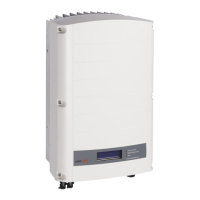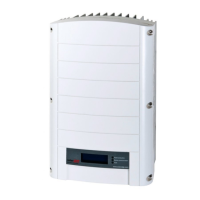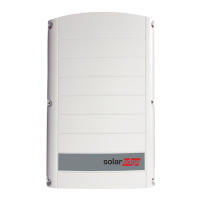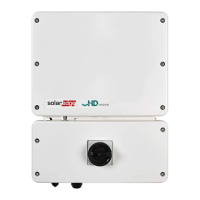How to fix String voltage is 0V on SolarEdge SE33.3K?
- MMrs. Beverly HillSep 5, 2025
If the string voltage is 0V on your SolarEdge Inverter, it means a power optimizer output is disconnected. To fix this, connect all power optimizer outputs.
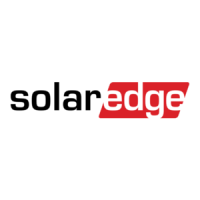
How to fix String voltage is 0V on SolarEdge SE33.3K?
If the string voltage is 0V on your SolarEdge Inverter, it means a power optimizer output is disconnected. To fix this, connect all power optimizer outputs.
Why SolarEdge Inverter has no Internet connection?
If your SolarEdge Inverter has no internet connection, it may be due to a failed ping to google.com. Connect a laptop to the network to check for internet connectivity. If there is no internet access, contact your IT administrator or internet provider. If you are using Wi-Fi, make sure the username and password match those defined in your internet provider's access point or router.
Why is string voltage higher than number of optimizers in SolarEdge Inverter?
If the string voltage of your SolarEdge Inverter is higher than the number of optimizers, there could be a few reasons. First, check if an extra power optimizer is connected in the string. Next, verify that only power optimizers are connected in the string and that no module outputs are connected without a power optimizer. If the issue persists, follow these steps: 1. Disconnect the wires connecting the power optimizers in the string. 2. Measure the output voltage of each power optimizer to locate any that aren't outputting the 1V safety voltage. Check the connections, polarity, module, and voltage of any malfunctioning power optimizers.
What to do if string voltage is lower than number of optimizers in SolarEdge SE33.3K Inverter?
If the string voltage of your SolarEdge Inverter is not 0V but lower than the number of optimizers, it could be due to several reasons. First, ensure all power optimizers are properly connected in the string. Second, verify that all modules are correctly connected to the power optimizer inputs. Lastly, check the string polarity using a voltmeter and correct it if necessary.
Why SolarEdge Inverter has no connection to SolarEdge servers?
If your SolarEdge Inverter cannot connect to SolarEdge servers, the ping or connection to the SolarEdge server may have failed. Verify the SolarEdge server address under the LAN Configuration sub-menu. The address should be prod.solaredge.com and the port should be 22222. Check with your network administrator to see if a firewall or other device is blocking the transmission.
How to fix LAN Disconnected on SolarEdge SE33.3K?
If your SolarEdge Inverter shows 'LAN Disconnected', it indicates a fault with the physical connection. Check the cable pin-out assignment and cable connection.
How to fix DHCP Failed or Invalid DHCP Config on SolarEdge Inverter?
If your SolarEdge Inverter shows 'DHCP Failed' or 'Invalid DHCP Config', it indicates an issue with the IP settings. To resolve this, check both the router and inverter configurations.
What to do if SolarEdge SE33.3K pairing failed?
If pairing failed on your SolarEdge Inverter, it might be because the power optimizers are shaded. If the inverter is connected to the monitoring platform, retry pairing remotely during sunlight. Ensure the inverter's ON/OFF/P switch is ON and that S_OK appears on the status screen.
What to do if my SolarEdge SE33.3K Inverter has no internet connection?
If your SolarEdge Inverter isn't connecting to the internet, connect a laptop to the network to verify internet access. If there's no internet, contact your IT administrator or internet provider. For Wi-Fi, double-check that the username and password match what's defined in your internet provider's access point or router.
How to fix SolarEdge Inverter pairing failed?
If pairing fails on your SolarEdge Inverter, it might be because the power optimizers are shaded. If you've connected the inverter to the monitoring platform, try pairing remotely during sunlight. Ensure the inverter's ON/OFF switch is ON and that S_OK appears on the status screen.
| Model | SE33.3K |
|---|---|
| Maximum Output Power | 33.3 kW |
| Rated AC Power | 33.3 kW |
| Max. AC Power | 33.3 kW |
| AC Frequency | 50/60 Hz |
| Number of MPPTs | 2 |
| Topology | Transformerless |
| Operating Temperature Range | -25 to +60 °C |
| Cooling | Forced Air |
| Ingress Protection | IP65 |
| Communication Interfaces | RS485, Ethernet |
Explains safety symbols like warning, caution, and notes for safe operation.
Covers critical safety precautions like handling voltage, grounding, and equipment protection.
Highlights safety notes and warnings specific to power optimizer installation.
Covers minimum/maximum string lengths and mounting requirements for optimizers.
Explains procedures for mounting the inverter vertically and horizontally.
Step-by-step guide for connecting the AC power supply to the inverter.
Guides through the process of activating the inverter and system components.
Details how to logically assign power optimizers to their respective inverters.
Describes how to confirm correct system activation and operation.
Guides for diagnosing and resolving communication errors, especially Ethernet.
Lists common problems with power optimizers and their solutions.
Explains how to calculate the correct circuit breaker size for an inverter.


